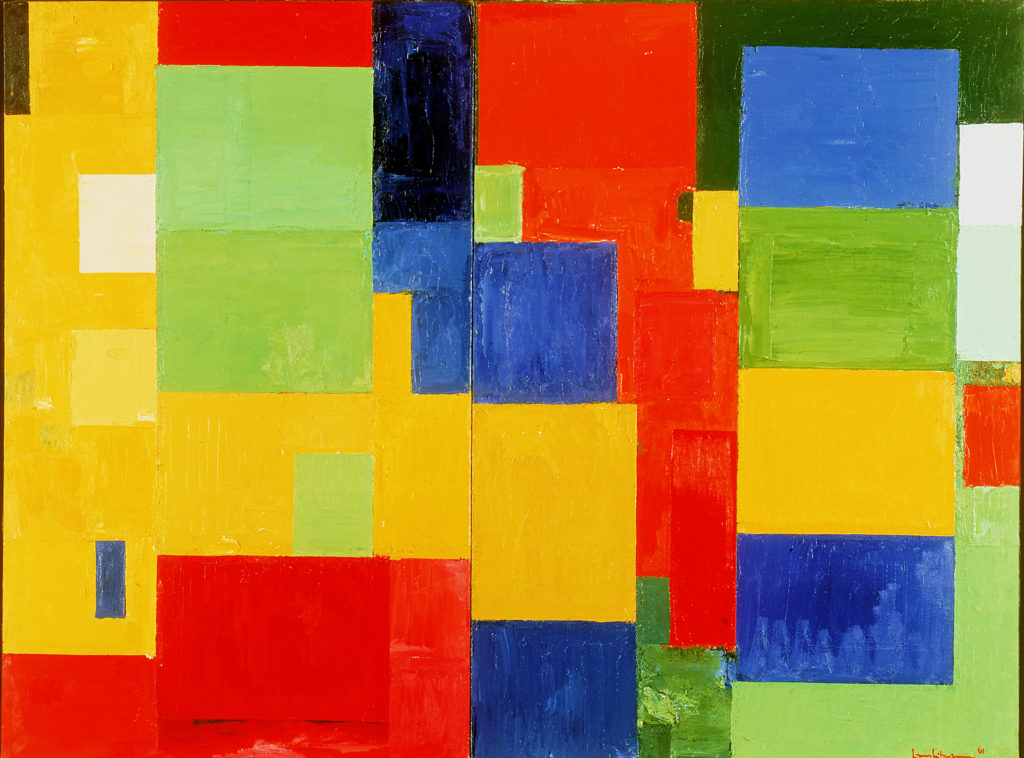[ad_1]
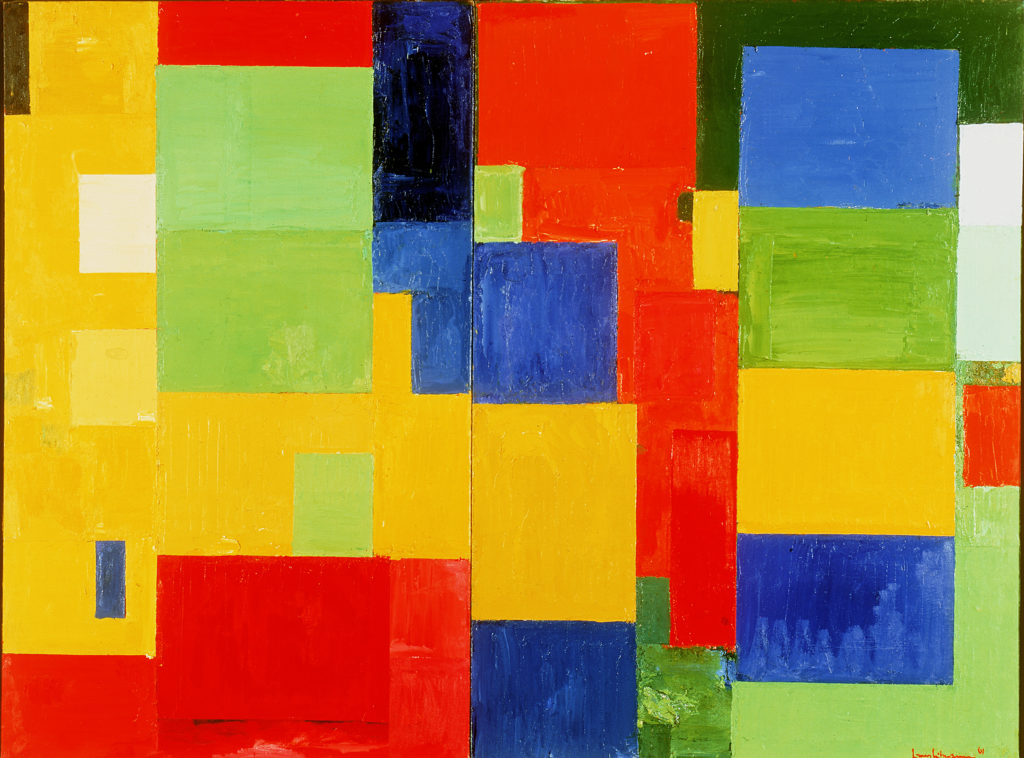
Hans Hofmann, Combinable Wall I and II, 1961, oil on canvas. The work was one of 40 included in the 1963 Museum of Modern Art exhibition in New York.
©THE REGENTS OF OF THE UNIVERSITY OF CALIFORNIA/BEN BLACKWELL/UNIVERSITY OF CALIFORNIA, BERKELEY ART MUSEUM AND PACIFIC FILM ARCHIVE, GIFT OF THE ARTIST
With a Hans Hofmann survey on view at the Berkeley Art Museum and Pacific Film Archive in California, we turn back this week to the September 1963 issue of ARTnews, which featured an essay on the painter by the New York School artist Fritz Bultman. Written on the occasion of a 1963 show of Hofmann’s work at the Museum of Modern Art in New York, for which the artist was billed as the “most influential art teacher of the 20th century,” Bultman’s essay addresses Hofmann’s many achievements, among them his ability to represent human nature via abstraction. Bultman also discusses the MoMA show, noting that it was presented in a non-chronological fashion, bringing an “end [to] its series of carefully documented and often lifeless presentations of modern artists. The essay follows below. —Alex Greenberger
“The achievement of Hans Hofmann”
By Fritz Bultman
September 1963
Notes by a well-known painter and former pupil indicate some of the triumphs of this master who is having a long overdue exhibition at the Modern Museum
“The duality of art is an inevitable result of the duality of human nature.”
Baudelaire
The first sentence of Hans Hofmann’s Plastic Creation publication in the Art Students League Magazine, New York, Winter, 1932-33, is: “The mystery of plastic creation is based upon the dualism of the two-dimensional and the three-dimensional.” Hofmann invoked duality, ambivalence and dialogue; however it is only in the latest decade that the possibility of maintaining two totally different painting expressions simultaneously has become an end in itself. A dialogue develops between those paintings that pursue the idea of a pure and rational plasticism and those spontaneous inventions that arise from an unconscious response to the means of art. In the exhibition at the Museum of Modern Art, the most pointed confrontation of those two statements is Combinable Wall, and the Tormented Bull, both 1961. The duality is at once the dialogue of the artist and his canvas, the artist and his nature. It is the duality of flatness and depth; of the concentration and dispersal of both the image and the plastic means simultaneously. It is what is revealed and what is veiled. That this duality should remain in the final work is also important for the beholder. It is only through the possibility of multiple “readings” that pictorial freedom is possible. It is through the double “readings” (i.e., of the painting as flatness and as space) that the artist gives the spectator a freedom of choice. Otherwise art becomes program, good or bad, but like programmed music, or TV dinners, predigested.
Throughout all of Hofmann’s work the deepest emotional response is most often awakened by the landscape. (Sometime in the late ’fifties after a sunset ride with Truro, Hans said that he would like to paint in the landscape again with what he knows now about painting). The last paintings, still untitled, have that sense of the glowing fusion of earth, water and sky that is notable in the early watercolors from 1914 painted at the Ammersee in Bavaria, and in the paintings of the Truro hills from the late ’thirties and early ’forties. Though the mood of the landscape continues in Towering Clouds, 1959, and Thunderclouds, 1961, these still speak of Hofmann and art and Hofmann and nature. It is really in this latest painting of 1963 that the glow of fusion is renewed and the painting transcends both nature and painting and affirms anew, with lucid unity, all life. Out of a decade of conscious duality that has produced paintings unique in their scope and in their use of the matter of painting, comes this summation. The “motif” of the earlier paintings has disappeared; what remains is an affirmation of the processes of nature, but as pure painting “through an esthetic awareness in response to organic life.” It is by using the inherent dynamics of duality, the fusion created by the friction of opposition, that a new order is created. Hofmann sees this process as leading to the creation of Quality that is the real goal of his esthetic.
He joins Monet and Mondrian in the creation of the image of the landscape of our time—reflection, structure and process. The unity throughout all of his painting is the spaciousness of landscape and an acceptance through the fusion of all things both of the balance and the “tragic . . . created by unequivalence” of the world. Like Louis XV, he “carries depravity to the point of enjoying simple nature.”

Hans Hofmann, In the Wake of the Hurricane, 1960, oil on canvas.
©THE REGENTS OF OF THE UNIVERSITY OF CALIFORNIA/JONATHAN BLOOM/UNIVERSITY OF CALIFORNIA, BERKELEY ART MUSEUM AND PACIFIC FILM ARCHIVE, GIFT OF THE ARTIST
Means and esthetics
Nothing is denied, withheld or suppressed by Hofmann in order to create a painting. Painting as the artist’s projection of himself and the idea of “what the image of art should be” are absolutely foreign to him. This sets him somewhat apart from most American painters of the moment, which is doubly ironic because Hofmann’s presence in the United States did so much to set American painting in motion. In Hofmann’s paintings, subject matter, plastic matter, object matter or whatever else are used, fragmented, analyzed, reformed, synthesized into a pictorial reality that says, “So I am at this moment.” Each picture is a new creation.
This cavalier use of the means of art, this disregard of a corporate image of what the artist should be and do, comes from a complete and total candor and a very healthy ego. It also stems from an enormous curiosity about art and life: gains in order to experience new worlds. This perpetual revolution is absolutely modern, and it is what makes Hofmann part of the future. If the modern movement is to move and not petrify into the elaboration of a small number of approved styles, something of this neutralizing of means and matter of art must be reintroduced into the mainstream of painting.
Hofmann says, “I can do anything as long as it is esthetically justified,” and by “esthetically” he means something both exact and elastic. To pinpoint this exact meaning of this term is difficult because on the one hand he refers it to the reality of the means (the two-dimensionality, the illusions of depth on the canvas, the use of painting as a non-nostalgic evocation), but, on the other hand, he refers it to the depicted as a pure and unsentimental force. Besides this, he gives “esthetic” an ethical value in relation to the artist’s own commitment. I think that when he qualifies it as “esthetic awareness,” he gives it its greatest elasticity for pictorial audacity.
However, it is through the term Quality that he gives art its most charged responsibility. It is by and through Quality that the real transmutation takes place. “It is not itself a physical, but a spiritual reality, though created by physical means. The imitator copies only physical reality and, as a consequence, uses the means only for limited ends. He does not realize that thereby he kills not only the intrinsic value of the medium, but also the creative faculty of the mind.” For Hofmann, Quality becomes the means whereby the artist most fully realizes his inherent potential and in so doing allows his art to serve as the springboard for further extrapolations. “We are therefore richly equipped to agitate the means to a Life and Light emanating rhythmic and plastic response.” By Quality he proclaims the primacy of the creative imagination.
His behavior toward the means and matter of art are risked as his ignoring of the “historic” exploitation of his own achievements. This all needs a freedom sadly lacking in our age of caution. A serious flaw in contemporary thinking has equated youth with audacity, when in fact the young of today are often quite nostalgic and their forms are timid and ingratiating. Hofmann’s audacity lies in his willingness to extrapolate upon experience; not to be satisfied with simple sequence, but to know that if one is firmly anchored, everything is possible in every direction. He always venerated the late Titians and Renoirs for their audacity.
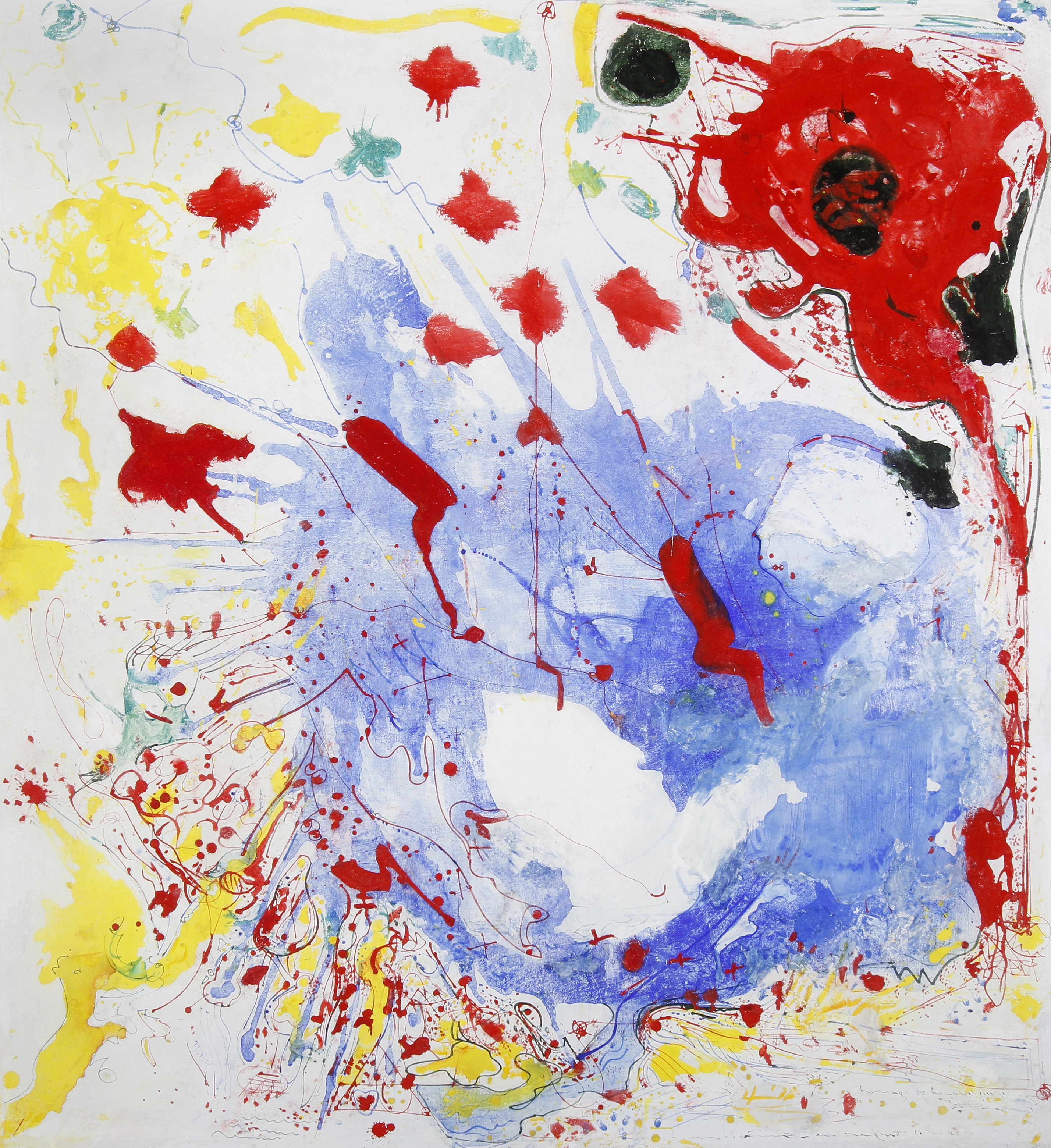
Hans Hofmann, Cataclysm (Homage to Howard Putzel), 1945, oil and casein on board.
COURTESY MILES MCENERY GALLERY, WITH PERMISSION FROM THE RENATE, HANS & MARIA HOFMANN TRUST/ARTISTS RIGHTS SOCIETY (ARS), NEW YORK/PRIVATE COLLECTION
Historic development
Hofmann has no single logical step-by-step evolvement—either in his life or art. After all, there have been three separate lives, three beginnings:
1880-1914—Munich, Paris
1914-1931—Munich
1932-now—California, New York, Provincetown
Practically all of the pictures from the first epoch have disappeared. One wonders what happens to pictures that have vanished. Some were in the collection of Freudenberg and Cassirer in Berlin, Hofmann’s Paris studio was confiscated during World War I and the pictures lost in France.
Of the second life, all the important pictures that were in Munich were destroyed by bombing in World War II. Only a few portfolios of “thousands of drawings” remain. The second life was literally the time of drawing, which preoccupied the artist except for a few canvases heavily surfaced from constant repainting. It was then that Hofmann formulated his concept of the plastic function, which was made concrete for him within the medium of drawing. Through the chance observation of a Romanesque capital in Southern France, he became aware that pictorial movement was not created directly by emphasis, but indirectly through the opposing movements (note to historians: he knew Hildebrandt’s Problems of Form well enough to have opposed its mechanical methods in his Munich school). A real duality of Hofmann’s nature and a red herring to those who would pin him down is his elaborate esthetic theorizing that is purely an activity in itself. He will build up a formidable intellectual structure only to demolish it by his own actions. And this stems from his insistence on experience and experiencing. To paint is to live each moment fully and to experience each moment, each person, each thing, uniquely. “If you put one hundred Coca-Cola bottles on a table, each has its own particular position in space in relation to each other, and each receives and reflects the light uniquely” (this was said in 1939 in regard to the constantly changing quality of reflection on Brancusi’s Bird in Space).
Hofmann never denies the forms and theories, he only says that they are not the whole story, and that only experience can tell you what part is really yours. Through being a part of the esthetic movements of the first quarter of this century, he knew first-hand the numerous theories of this time, but he had a certain aloofness and unwillingness to join in these formulations, as well as a certain unwillingness to publish his own writings. For example, he knew of Kandinsky’s work at first hand since Kandinsky’s entire Munich production was in Hofmann’s studio during the First World War. But although Hofmann arrived at a non-formal abstraction in the 1940s and although in his writings he speaks of lines and planes, there is the essential difference in the concept of Volume. Kandinsky’s paintings and formulations are based upon the articulation of the reconstruction of this surface that Hofmann bases his entire ambivalent concept of flatness and depth. It is also by his insistence on this concept of Volume that his painting incorporates Cézanne and the whole Cubist tradition into non-figurative painting. He knew Braque, Picasso and Delaunay as personal friends in pre-World War I Paris. Even at this time, he was aware of the complementing duality of Cubism’s concern with form as volume, and Fauvism’s concept of color as volume. It is natural that he tried to incorporate these conflicting, yet complementing concepts in his own work. He believes that by denial of forms one may affect quick temporary results, but only by the incorporation and understanding of the total art of the past is the artist able to move and change forms radically from within. Without this understanding of the underlying forms, there may be spurts that end in a gesture of defiance, but never the real changes that give to art its continuing vitality.
Hofmann’s drawings of the 1920s ignore the conventionalized Expressionist distortions of that time. They are conceived as volumes of negative space articulated by the positive volumes of the human figure. Although an awareness of Cubism is implicit in this work, the people are seen as individuals with all their personal uniqueness. These drawings join a great tradition of German art that is concerned with an exact observation of persons, phenomena and objects.
There are landscapes and still-lifes from this time, too, but the portraits are predominant. Hofmann brought this preoccupation with the figure of New York with him, and there are a few figure paintings and portraits of mid-’thirties. But the summation of this concern with the figure comes in a group of highly humorous self-portraits, then it is transformed in two large paintings in the exhibition, The Idolatress, 1, 1944, and Bacchanal, 1946. In these, the grace and function of the figure is evoked rather than stated with consecutive anatomy; they contained the possibility of a new figure that has been unfortunately ignored by most young painters, as we saw in the “New Images of Man” exhibition. But with these paintings Hofmann’s interest in the figure passes.
It is after this, but through these human transformations, that the freedom of the painting of the mid-’forties begins—painting in which the spontaneity of means and pictorial invention is paramount. Many of these (in watercolor and gouache) have never been shown.
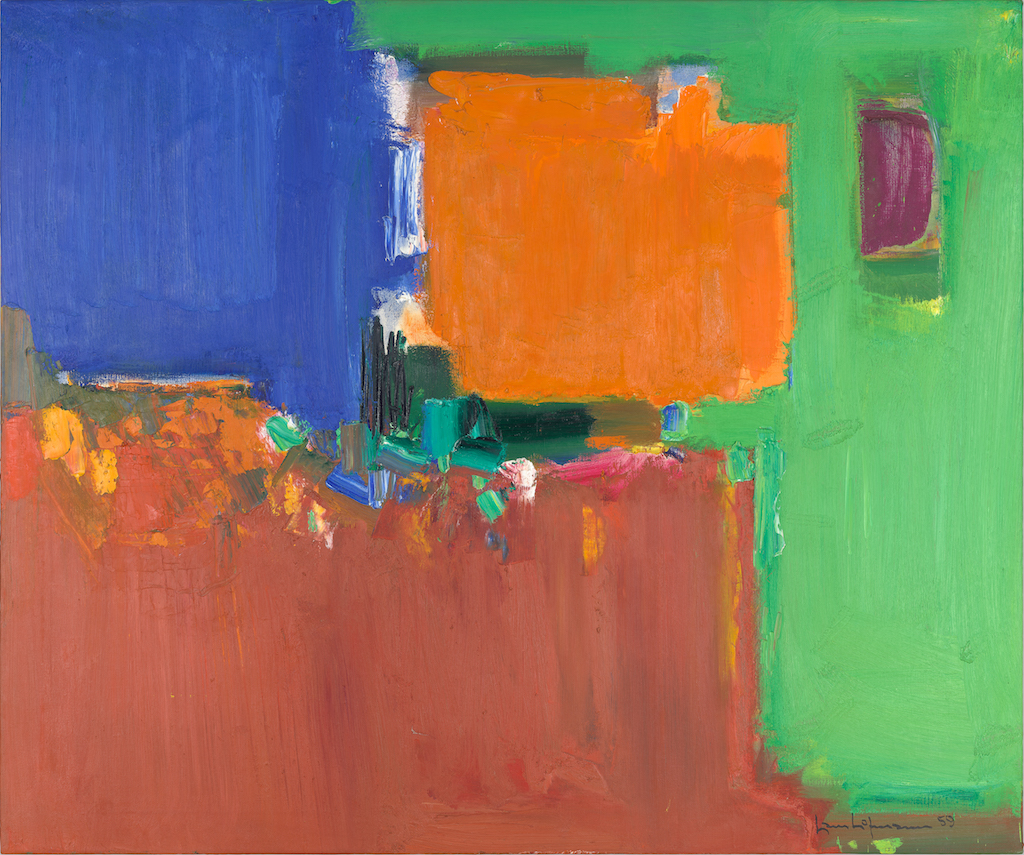
Hans Hofmann, Indian Summer, 1959, oil on canvas.
©THE REGENTS OF THE UNIVERSITY OF CALIFORNIA/JONATHAN BLOOM/UNIVERSITY OF CALIFORNIA, BERKELEY ART MUSEUM AND PACIFIC FILM ARCHIVE, GIFT OF THE ARTIST
The spiritual
“Spiritual” is today so full of connotations of cultism, occultism and trailing chiffon, that even organized religions shun the word. It was a living force to both the hard-headed Symbolists and the generation that followed. Mondrian, Kandinsky and Hofmann used and can use the word unabashedly and give it fresh meaning and force. Symbolism’s insistence on the unity of all arts, particularly music and painting, has led to a certain vocabulary common to both Hofmann and Kandinsky in their theories of color; but Franz Kline’s relating his good work times to the flying moments of jazz brings this aspect into focus for all.
Hofmann’s concept of the spiritual has another dimension; for him it is life as an organic continuation of the sensuous world—no dualism here. For him there is a continuity from the brain which controls bodily functions through the cortex of senses and emotions “to a complete awareness” of the world. His spiritual is basically a cosmology, the sense of a completely free man in a space that is at once the space of the microscopic and the space of the stars; a universe in which both space and man are “all energy.” His view of the deep subconscious as “the conductor of our minds in the art of creation” envisages the body-controlling mind as a companion of the spiritual, and the simplest bodily functions as part of a universe pulse.
This awareness pf the unity of the micro- and macrocosmos as extensions of sensuous perception places historical time outside of his sense of nature. He sees nature as a balance in complete tension that can only move to a new tension by pulse and rhythm. (Pulse and pulsation are implied in his sense of painting as an impulse; also the idea of cosmic play—the world created by divine impulses.)
The organic cannot be assigned to one section of life and art and denied to another. If accepted, it permeates all actions, all forms—otherwise it is just a tag-word to justify eccentric behavior. Hofmann’s sense of time alone shows how different the organic concept is from the historic. His concept of this is part of his idea of experience as different from, but complementing, knowledge. Autobiographically, this explains his willingness to begin at the beginning over and over again. Not with what he knew theoretically, but from what he experienced at “that” moment.
Hofmann found himself stranded in New York through the sudden rise of Hitler in Germany in 1931 (the hostility of the Nazis to modern art was understood immediately by Miz Hofmann who counseled him not to return to Munich). And when he began to paint again it was not out of the freedom he had won through the drawings, but with a careful color analysis of forms—a structured feeling into the nature of light and space. It is natural that his painting moved quickly away from this, but the important thing was his finding the beginning point from which to move.
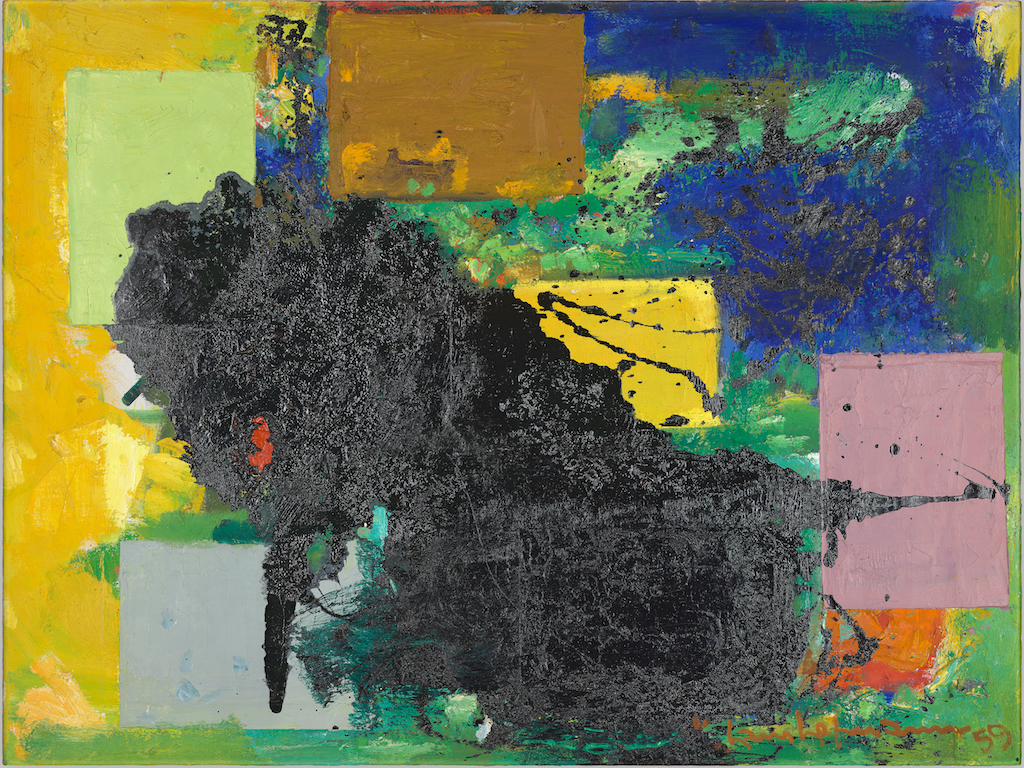
Hans Hofmann, The Vanquished, 1959, oil on canvas.
©THE REGENTS OF THE UNIVERSITY OF CALIFORNIA/JONATHAN BLOOM/UNIVERSITY OF CALIFORNIA, BERKELEY ART MUSEUM AND PACIFIC FILM ARCHIVE, GIFT OF THE ARTIST
Notes on the exhibition
“In New York everyone wants to be ‘Kunstpapst’ ” . . . Miz Hofmann
It would be fitting with the showing of forty paintings of Hans Hofmann, chosen for quality rather than to demonstrate his development, that the Museum of Modern Art would drop its role as keeper of the keys of modern art history; no position is more frivolous than that of esthetic Couéism or more false to the creation of art. For Baudelaire’s modest proposal of a century ago—“to build a rational and historical theory of beauty, in opposition to the theory of a beauty that is single and absolute”—has become as much of an iron maiden as the canons of the Academy that he sought to overthrow. It is particularly fitting that the Museum should end its series of carefully documented and often lifeless presentations of modern artists and start a new tack with Hofmann, since his work just doesn’t develop along the mechanical lines of approved biographies.
It is a great pleasure just to see pictures on their own without program, without chronology, without reference except to show themselves and the artist. And if the Museum has waited until now to show Hofmann, it is perhaps that such an atmosphere was necessary in order to present him. Despite Hofmann’s copious writing that makes him a leading theoretician of modern esthetics, this facet of his creativity is only a facet. No artist is less armored by theory and style; no artist more willing and able to jettison any concept if his intention tells him to move on, or to deny an esthetic imperative.
At this point any retrospective of Hofmann is impossible. It would take a dedicated team of art historians years to trace the paintings from his Paris studio and to try to trace those paintings and drawings in Germany not destroyed in World War II. The few personal portraits remaining in Hofmann’s possession give only a glimpse of what this work was like, and records of work from this time are also non-existent. William Seitz, who assembled this show, bypassed this aspect deliberately by insisting upon a free show of “forty beautiful paintings forty,” with an open door at this end for new work.
The incentive for discovery of the early work can be Hofmann’s gift to the enterprising art historian whose path he has so unconsciously littered with red herrings and new beginnings. Exhibitions of the drawings and watercolors of the mid-’forties are something that we can all await; this present show will certainly whet appetites for more of this world in which invention and automation create a sense of balanced well-being. Even the brightest and most aniline of colors glow and harmonize through quantity of color weighed against unequal but equivalent brilliance. In the most geometric paintings there is an emphasis on the fugitive qualities of color. For in these paintings there is no attempt at a psychologically overwhelming expression, but rather a persuasion through balance and movement and the glow of human warmth.
[ad_2]
Source link

